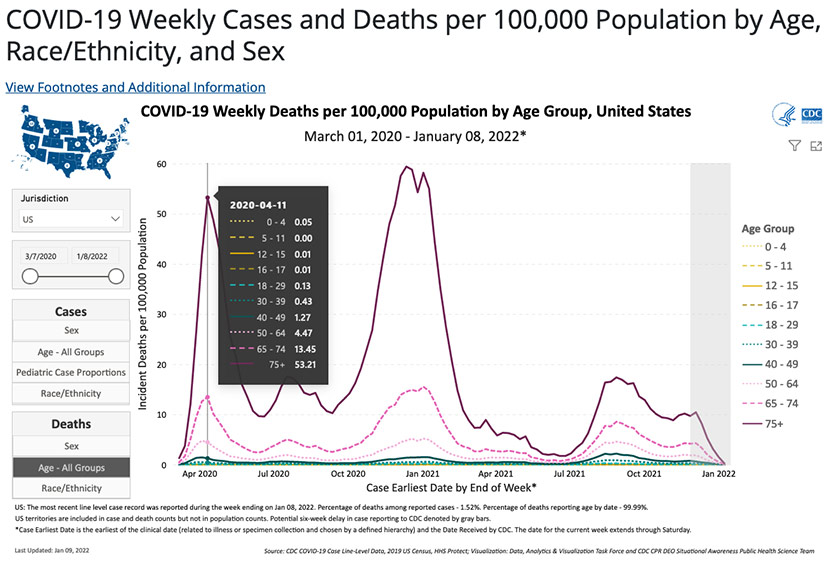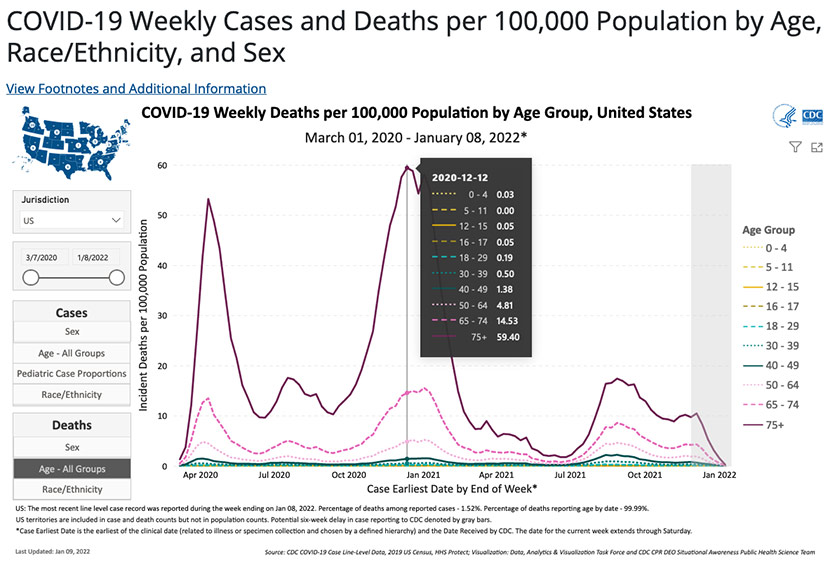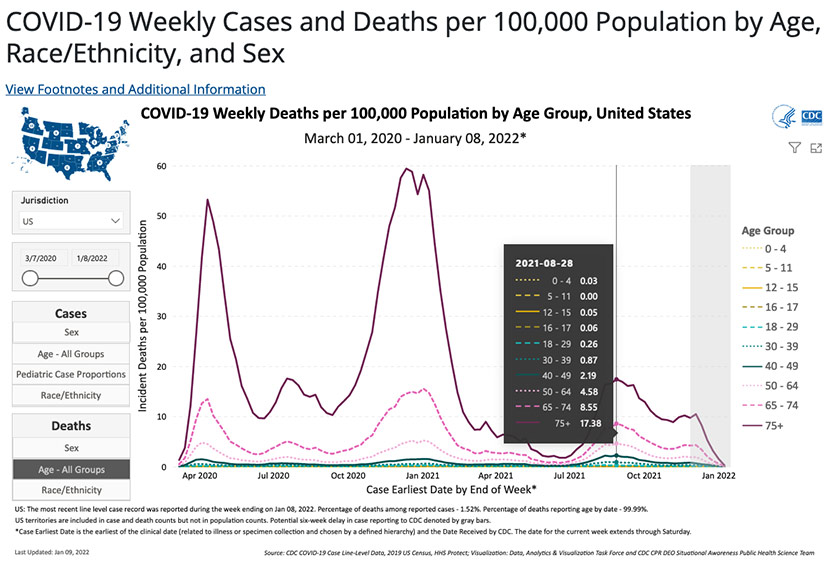My granddaughters Simone and Amelie were home all day on Friday, because Pagosa Peak Open School had returned to ‘distance learning’ for a few days, due to a staffing shortage.
A COVID-generated staff shortage. A person who is fully vaccinated but still tested positive, if I’m not mistaken.
I enjoy having the kids home. Watching them do their online lessons. Taking them to the library, or shopping. And of course, the snow at Wolf Creek is still lovely, if you’re home from school. (I don’t ski, but the rest of the family are snowboarders.)
COVID is still making waves in Archuleta County. New cases had fallen off after Thanksgiving, but started climbing again after Christmas — apparently coinciding with the arrival of the Omicron Variant. The mainstream media has been reporting increased cases all around the country.
On December 14, a news story from NPR announced the sad news that 800,000 Americans had been killed by the coronavirus… although it’s not entirely clear if all those people were “killed by the virus” or if they “died while having a COVID infection.”
But the number “800,000” struck me as slightly odd. Wasn’t America very close to that number already, last winter? Shouldn’t we be much higher than 800,000 by now?
Maybe we are doing a better job at successfully treating people with COVID infections? One would certainly hope so.
When I double checked the news accounts, though, it looks my memory was faulty, and that the death toll has been fairly steady. America hit 700,000 this past October, 600,000 in June, and 500,000 last February.
So then, during the first year of the pandemic, the U.S. saw about 500,000 alleged fatalities. During the second year — with about half the population vaccinated, and with the arrival of the Delta Variant — the number was apparently closer to 300,000.
Now, lately, cases are increasing in many places, including La Plata and Archuleta counties. We are told that say Omicron is highly contagious, even for those who are vaccinated.
But is it deadly?
Here’s an interactive chart I found on the CDC (Centers for Disease Control) website yesterday. This version if the chart shows the alleged COVID deaths according to age, with the most dramatic (purple) curve showing victims age 75+.
The black block of numbers points to the worst week during the first spike of deaths: the week of April 11, 2020. Among 75+ population, we saw about 53.21 fatalities for every 100,000 people aged 75+. We note the weekly deaths among children under the age of 17 was extremely low. Among 5-11 year-olds, it was 0.00.
Granted, this is government data, so we want to skeptical about its accuracy. But what we want to compare here isn’t necessarily the accuracy, but the general trends.
In the next screen capture, we’re looking at the spike of deaths, the week of December 12, 2020. It was a tough holiday season for many families, as the death rate among 75+ year-olds hit 59.40 per 100,000 population.
Young people were hit a bit harder during the December 2020 spike, but the rate among children 17 and younger was still 1,000 times less than among the very old. Children age 5-11 remained at 0.00
The next spike hit during the week of August 28, 2021, as shown below. The deaths among 75+ were much less — about one-third the rate we saw during the 2020 holidays. Children 5-11 remained at 0.00.
The website didn’t explain why the chart was shaded ‘gray’ starting the week of November 27, 2021. But that was the week that the Omicron Variant was discovered in the UK and Canada. So I assume the gray shading is meant the indicate ‘The Arrival of Omicron’.
Finally, we arrive at the week of January 8, 2022, below. Readers may have already noticed (in the charts above) that the death rates, among all age groups, dropped of drastically starting around the time Omicron arrived. As the black box numbers indicate, for the week of January 8, all groups of children age 17 and younger are 0.00. None of the rates are more than 0.27.
The death rate among seniors age 75+ is 200 times lower than in December 2020… and seven times lower than the previous low point in June 2021.
There are at least a couple of explanations for this remarkable result. Maybe more.
One is: the data is seriously incomplete, and will be fixed in a future update.
Another is: the national vaccination program has been a remarkable success, and almost no one is dying of COVID in 2022.
Yet another is: the Omicron Variant is terribly contagious but very rarely fatal.
A few days ago, NPR (the same folks who set me off on this little research project) ran a story about two Texas-based virus researchers who have developed a very low-cost vaccine that’s now being administered in India, after being found to be about 80% effective against the Delta Variant. It can be produced for about $1 a dose… compared to the Pfizer vaccine which runs about $39 for two doses.
But it’s not an mRNA vaccine, so it doesn’t have a ‘cool’ factor. This vaccine — named CORBEVAX — is based on an older technology, similar to that of the Hepatitis B vaccine developed decades ago.

The paragraphs in the NPR article that struck me as especially hopeful, were these:
When a strain of coronavirus known as SARS broke out in 2003, [medical researchers Peter Hotez and Maria Elena Bottazzi] decided to tackle that disease. After moving to Houston to affiliate with Baylor College of Medicine and the Texas Children’s Center for Vaccine Development, they created a vaccine candidate using protein subunit technology. This involves using proteins from a virus or bacterium that can induce an immune response but not cause disease…
Their SARS vaccine candidate looked promising, but then the SARS outbreak petered out. No evidence of disease, no need for a vaccine.
Hotez and Bottazzi dusted off that old SARS vaccine, updated it, and tested it against COVID-19… with good success.
As some might remember, the SARS outbreak — also a coronavirus — started in 2002 and lasted about 18 months. Then the virus vanished without a trace. There have been no confirmed cases since 2004.
How does such a thing happen? A virus just up and vanishes? Or… becomes much more contagious, but much less deadly?
How little we understand about these things.




